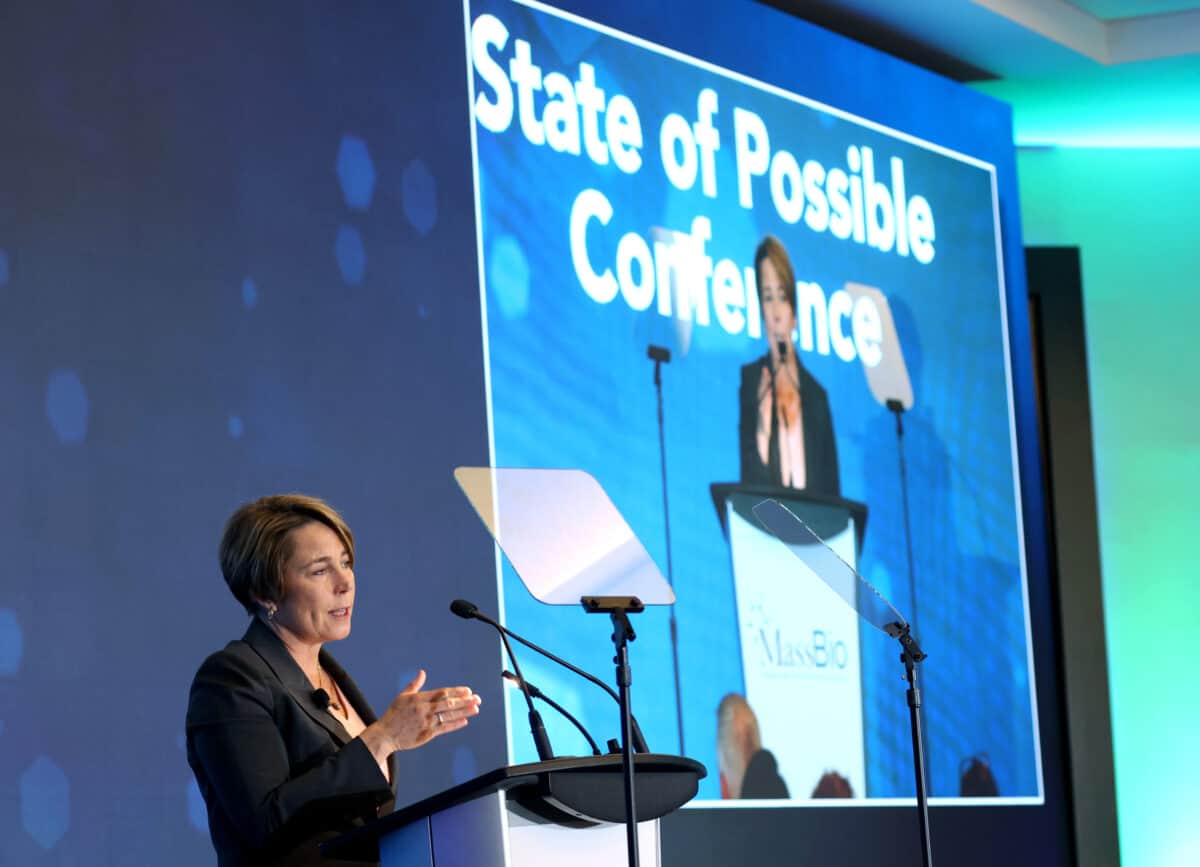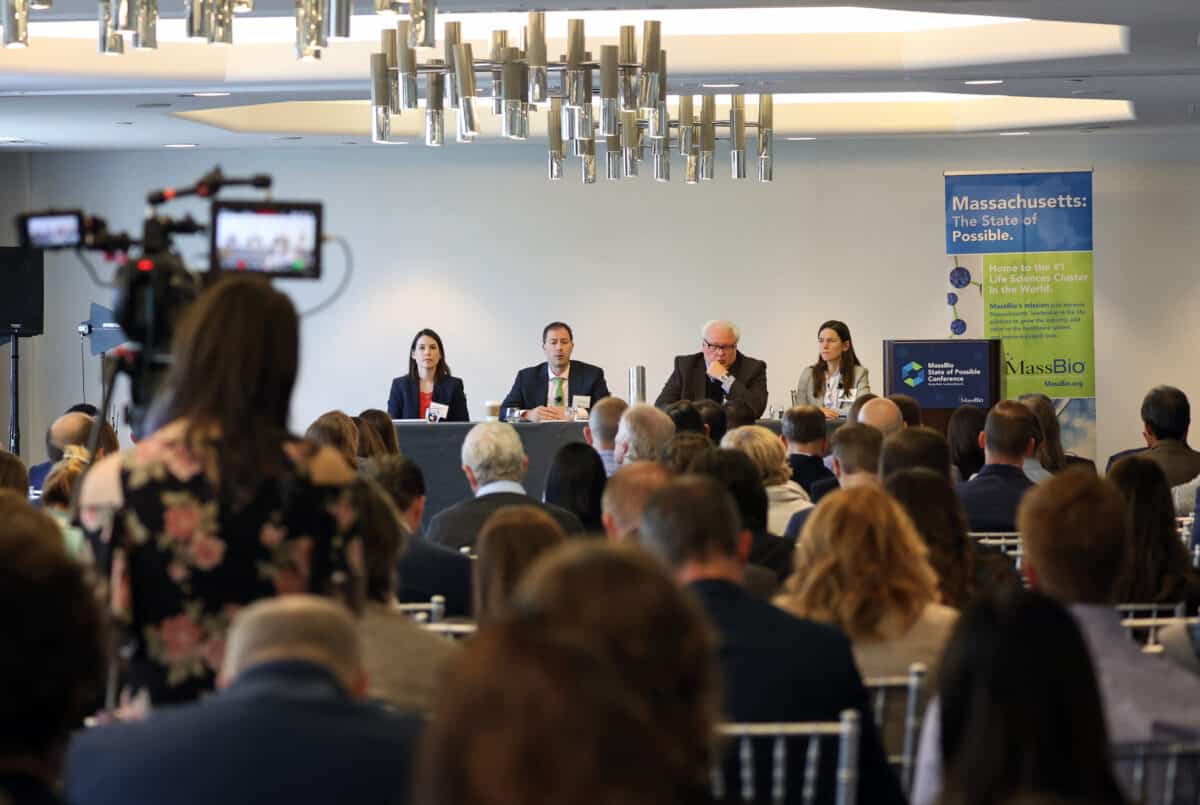
This year’s MassBio State of Possible Conference had two distinctly different conversations about public policy. The main stage featured one that was both honest about the threats to state’s competitiveness and optimistic about the future of the life sciences industry here in Massachusetts. In a breakout session, however, a panel of experts delivered a frank assessment of the unintended consequences on innovation brought on by significant federal legislation passed last year.
Both takes are accurate. Both messages are important.
Governor Maura Healey wasted little time in ticking off Massachusetts’ strengths around human capital, intellectual capital, and a history of innovation in her morning speech. She quickly credited the importance of teamwork and collaboration to meet the current moment, and how she plans to make our foundational public-private partnerships even stronger.
She earned extended applause when she spoke to the danger of allowing politics rather than science to drive innovation, referencing the Texas judge’s ruling aimed at unraveling the drug approval structure of the FDA.
And she didn’t shy away from the very real challenges facing the state from workforce to housing to childcare. It will require a statewide effort, she said, to make Massachusetts an affordable place where families and businesses not only exist but thrive and grow.
“We are not looking for excuses for people to leave,” she said in her conversation with MassBio CEO and President Kendalle Burlin O’Connell, having also noted that other states and cities are on our heels. “We are playing to win.”
And what does that look like to her Administration? Creating a climate that is good for business. A coordinated effort when it comes to workforce and being intentional on building the talent pipeline. Acting together to secure federal funding and agencies like ARPA-H. Taking advantage of the entire state and its resources. Driving up housing production.

A few hours after the governor’s remarks about state policies aimed at lengthening our lead in the life sciences, a panel assembled down the hall to address a threat to local innovation emanating from the nation’s capital.
The drug pricing provisions of the Inflation Reduction Act, though well intentioned, are shaping up to have a very real impact on the discovery and delivery of therapies to people with unmet medical needs. The panelists didn’t hold back in delivering the sobering news.
Duane Schulthess, CEO of Vital Transformations, presented his company’s modeled analysis that found a significant loss in net revenues over 10 years upwards of 40 percent across 41 firms. These revenue losses translate into a 40 percent drop in assets, or a loss of 37 new therapies (three-quarters being small molecules). Here in Massachusetts the economic impacts will range from 5,000 to 10,000 direct job losses, and 24,000-47,000 indirect job losses.
Not surprisingly, Nick Shipley of BIO says he hears often about how the price controls in the IRA are impacting the ability of small biotechs to raise capital now that there is a hard ceiling when it comes to an investors’ return on investment. Leslie Wood from PhRMA echoed the same concerns, lamenting that “fewer innovation dollars will lead to access problems for patients, especially those with unmet needs.” She referenced the fact that while U.S. patients have access to 85 percent of new medicines through a government health plan, patients in OECD countries, where government price setting of drugs is widespread, have access to just 29 percent.
“We do worry that we will begin to slide in that direction in the coming years as IRA pricing comes online,” concluded Wood.
Shipley also homed in on how what wasn’t in the bill could lead to calls for additional action as consumers fail to see an impact on what they’re paying at the pharmacy counter. “This bill was explicitly targeted on this industry,” Shipley said, pointing out that the lack of hospital, PBM, and insurance plan provisions. “There’s nothing to require that all these new discounts get passed on to patients.”
Not to simply sound the alarm without offering solutions, each speaker did express opinions on what can be done “around the edges” to soften the blow of the IRA, and what the future may hold on implementation. But the reality is bleak if changes aren’t made along the way.
Two of my takeaways from these policy heavy moments on the same conference agenda are these: Massachusetts can continue to soar as the life sciences leader; and, we must stand up for science and innovation in the face of politics.
MassBio is eager to partner with the Healey administration to address the first by expanding the talent pipeline and addressing the threats to the state’s competitiveness.
We are equally ready to work with the Biden administration to adopt a “do no harm” approach to implementing the drug pricing program.
Patients look to Massachusetts for hope and we must do everything in our power to continue to deliver for them.